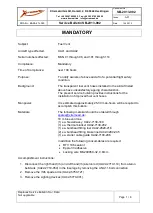
F
F
L
L
I
I
G
G
H
H
T
T
T
T
R
R
A
A
I
I
N
N
I
I
N
N
G
G
S
S
U
U
P
P
P
P
L
L
E
E
M
M
E
E
N
N
T
T
for SPORT
STAR
Light Sport Aircraft
Document No.: S2006FTSUS Revision: -
Date of Issue: 15/01/2006
Page:
121/130
4.20.3 Engine Failure in the Circuit
4.20.3.1 General comments
Not all pilots fly their circuits to the same parameters such as height,
distance out and speed and therefore only general comments can be made
about the options a pilot has. However, in general, whenever an engine
failure occurs above 500 ft in the circuit the pilot should do the following:
1. turn toward the runway. Turning to the runway may mean going for
an intersecting runway as opposed to the departure runway. The
wind direction will be an important factor in this decision.
2. acquire and maintain the best glide speed and make sure the flaps
are up. This will give you the most time to make a decision on
what you are going to do. Make sure you hold that speed all the
way to final approach to maximize ground travel and minimize the
potential to stall.
3. decide what you are going to do.
4. inform circuit traffic that you have an engine failure and what your
intentions are.
5. when it comes time to lower flap, do so in stages. Lowering flap all
at once could put you into a low situation and make you land short.
It is far better to land long and go off the end at low speed than to
land short at high speed.
6. If the runway is long enough, plan to land up to 1/3 past the
threshold. Then if you make a mistake you can still land on
pavement short of your intended touchdown.
A corollary that falls out of this discussion is that you should fly circuits as
tight as local procedures allow and then you should practice engine failures
from several different positions. When you do this you start with all the
advantages – no surprise, probably already have a plan, and no pressure
because you have a good engine to get you out of trouble. However, when
it happens for real it is a big surprise and the psychological pressure on
you, knowing you only have one chance at success, is huge. If you weren’t
thinking about it you have to make a plan that includes wind consideration.
Another unexpected factor is that a stopped prop or a spinning prop on a
dead engine creates more drag than you have ever had from a prop










































